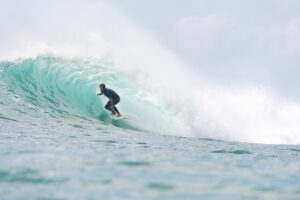
After learning to catch white water waves and consistently stand up, a beginner surfer typically looks to understand how to get through the breaking waves and catch and ride unbroken waves all the way to the shore, both frontside and backside. To help you achieve this faster, we’ve gathered some of our top tips for making the transition from a beginner surfer to an intermediate one.
- Choose the Right Board
When learning to surf, it’s crucial not to make the mistake of using a board that’s too small for you. In your early sessions, you’ll generally use a foam board, which is the easiest and safest way to learn. After that, we recommend buying or renting a longboard made of fiberglass, epoxy, or cork. At this stage, buoyancy is the most critical factor, so you should use a board with more volume. This will allow you to catch more waves with less effort, practice your body positioning, and have stability in weaker waves.
- Correct Your Take-Off Mistakes
When learning to stand up on the board, surfers often develop bad habits unknowingly. Common mistakes include bending the knees too much, looking down, not creating enough space under the body, and improper hand usage. If you feel you need help correcting your take-off, you can look for online resources that guide you through take-off techniques and help you fix these errors.
- Adopt Proper Surf Positioning
Intermediate surfers maintain a low center of gravity and distribute their weight properly on the board for greater stability. Practice surfing in a compact position, which will allow you to generate speed and make turns efficiently. Ensure good balance and situational awareness while standing on the board.
- Learn to Angle the Take-Off
By angling your take-off, i.e., taking a diagonal path to the right or left, you can gain several benefits while surfing. It will be easier to draw your line on the wave’s shoulder, build momentum in the direction you want to go, and have more time to stand up on the board. This is especially useful in fast waves where there’s no time to paddle straight and then pop up the wave.
- Master Foot Movement on the Board
Moving your feet forward gives you speed, while moving them backward allows for more efficient turns. If you stand too far forward on a longboard, you’ll struggle to make proper turns as there will be too much weight on the board’s nose. Conversely, moving your feet backward will help you accelerate. Practice sliding your feet up and down the board to adjust your position as needed.
- Seek Suitable Waves for Your Level
Just as there are world-class waves for advanced surfers, there are also perfect waves for beginners and intermediates. Pay attention to this and plan your future surf trips with suitable conditions in mind. Look for mellow waves with good paddling time and well-defined peaks both right and left. This will help you make significant strides in the techniques you’re trying to learn and enhance your overall surfing skills.
- Practice and Seek Surf Resources
Consistent practice is essential for improving as a surfer. Additionally, look for online resources that provide detailed instructions, tutorials, and tips to help you progress faster. Take advantage of the tools available to study and better understand surf techniques and fundamentals.
Remember that the transition from a beginner to an intermediate surfer takes time and practice. Enjoy the process and don’t get discouraged! Surfing is an exciting and challenging sport, but with dedication and effort, you can reach your goals and become a more skilled surfer.





